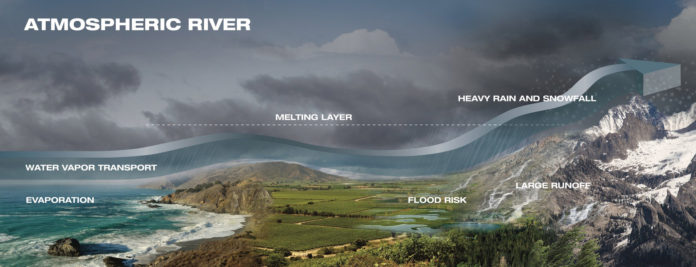Researchers from the University of California San Diego’s Scripps Institution of Oceanography announced earlier this week that they had created the first working model to score how powerful so-called atmospheric rivers are.
Since the term is likely as new to you as it is to most Americans, an atmospheric river is a drawn-out, skinny region miles above the Earth that transports the vast majority of the world’s water vapor. Keep in mind that atmospheric rivers do not contain water vapor from tropical regions of planet Earth.
Atmospheric rivers are towed by weather patterns across the Pacific Ocean and the West Coast of the United States. They eventually unleash massive amounts of water sourced from the Pacific Ocean. Experts indicate that such water vapor can be sourced from as far away from the West Coast as the state of Hawaii.
Roughly half of California’s annual precipitation comes directly from atmospheric rivers. Further, some four-fifths of all of California’s levee breaches across the state’s Central Valley region are tied directly to the phenomenon of atmospheric rivers. Since these weather events often result in floods, mudslides, and other natural disasters, researchers felt that it was necessary to begin rating them.
The University of California San Diego’s research was published in the popular meteorological journal titled Bulletin of the American Meteorological Society earlier this week.
Atmospheric rivers (AR), just like hurricanes and tornadoes, will be graded on a scale from one to five:
- AR Category 1 – Also called weak atmospheric rivers, these events are almost entirely beneficial for California and neighboring states.
- AR Category 2 – Moderate ARs, these weather events can prove to be hazardous on some occcasions. However, their effects are primarily beneficial to the short-term environment of lands they fall on.
- AR Category 3 – Referred to as strong, these atmospheric rivers offer a more-or-less equal balance of hazardous and beneficial effects.
- AR Category 4 – Considered to be extreme, these ARs almost exclusively provide the lands they reign over with hazardous outcomes.
- AR Category 5 – These atmospheric rivers are thought of as exceptional. They rarely provide even the tiniest amount of benefits to areas where they strike and are primarily hazardous.
F. Martin Ralph of Scripps and Jonathan Rutz of the National Weather Service were the two leading developers of the scale.









